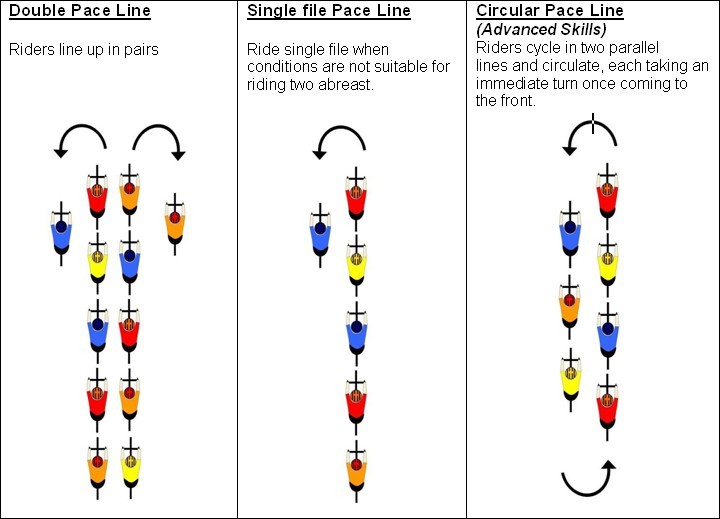Velominati Keepers of the Cog
You are probably familiar with at least some of the "rules" but to refresh, and get a chuckle, here they are. velominati.com
|
Paceline Etiquette Refresher

Note: On Summit rides when in a double paceline, both riders typically pull off to the left, one staying in front of the other and both staying tight to the group while drifting to the back. Our roads are busy so care must be taken to avoid pulling off the front into traffic.
Here are some general rules for riding in a paceline. They are not the last word in pacelining but if you know these then you know a good bit. There is no mention of echelons, etc.
IMBA developed the "Rules of the Trail" to promote responsible and courteous conduct on shared-use trails. Keep in mind that conventions for yielding and passing may vary in different locations, or with traffic conditions.
... what a bunch ride should be, and more importantly, what the leaders of the ride should be.
By Ed Borysewich
Velominati Keepers of the Cog
You are probably familiar with at least some of the "rules" but to refresh, and get a chuckle, here they are. velominati.com
Bike Handling When You Flat

Flat handling techniques for the wilds of New Jersey
Copyright Glenn Page, all rights reserved.
Rear Wheel Flat
Bam. Your rear tube just blew.
Don’t panic. Most 21-23 mm road tires will stay on the rim even while completely flat.
You do though have some business to attend to quickly.
First - DO NOT SLAM ON YOUR BRAKES. You’ll wreck and you will likely crash the next four cyclists behind you. Instead, get off the gas and begin coasting to a stop.
Immediately announce, "Flat!" "Slowing!"
Let the field go by. Do not make any sudden moves. Concentrate on keeping your bike straight and stable, allowing it to slow on its own until you can safely merge off the road and apply your brakes gently to bring the bike to a complete stop.
Emergency over. Fix the flat. Your friends are getting impatient.
Front wheel flat
A flat in your front tire requires special handling. Your steering will be wobbly and bike response sluggish.
Front flat rule number one: Except in situations where your life is in imminent danger (e.g., FedEx truck grill), do not attempt to turn the bike and do not use your front brake.
Tire separation from the rim is increased substantially with hard braking and/or turning on a deflated front wheel.
If you must brake, apply your rear brake with soft to moderate pressure.
Depending on your speed, you may have to compensate for the fact that bikes can dive forward under braking and unweight the rear wheel. You should be prepared to get your rear end in back of your saddle to balance the bike while braking. Coasting or very soft braking will help avoid this. (If you are unfamiliar with this technique, please see me or one of the other LCI’s in our club.)
This should do the trick in most group riding conditions you will encounter in our area.
... Unless you’re carrying more than 20 mph speed, in a sharp curve, on a steep grade, or all of the above.
Which, of course, you are. On to this predicament in part two.
Extreme Condition Flatting*
Ok... There is no avoiding it. Your situation is not optimal.
Getting out of this is going to take nerves of steel and calm action. So, stop screaming and pay attention.
DON'T TURN. Try it and you will flip.
You will likely have to brake.
Start with your rear brake - this time hard. You know that bikes dive forward under braking unweighting the rear wheel, so be prepared to get your rear end in back of your saddle to keep the bike upright.
If the biking gods are with you, this has done the trick. Speed is bleeding off and you are hovering over the back of your saddle to balance the bike as you slow.
If not, rule number one is still in force. Do not turn. Scan for soft landing opportunities. A field is a better option than over the handle bars, or into a tree.
Your front brake is a last resort - used to bleed off speed suddenly before you wrap yourself around that tree. (Fair warning: You will catapult over the bars if you do not get your weight back.)
*A short editorial here: If you do not have training at high speed cycling, and are not familiar with the extreme handling techniques required... What the heck are you doing over 20 mph, on a sharp curve on a steep downhill; or, in the middle of a fast group, over your limit and about to blow? 90% of crash avoidance is using your brain to avoid dangerous situations. If you want to go fast, make sure you have the skill to go with it.